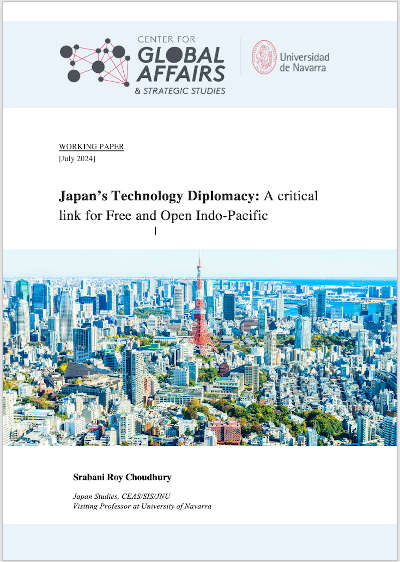En la imagen
Japan Radio Tower in Tokyo [mrsiraphol]
INTRODUCTION
The world is undergoing a significant transition. A simmering rivalry between the US and China for global dominance is reshaping the geopolitical landscape. The production hub has shifted from the Atlantic region to the Indo-Pacific region, now home to over 60 percent of the world's population. China, Japan, and India, the world's first, fourth, and fifth largest economies, respectively, contribute to over 70 percent of the world trade through this vast ocean space. This transition is further accelerated by a momentous technological change known as disruptive technology. Disruptive technology, by definition, is an innovation that fundamentally alters how consumers, industries, or businesses operate. It reshapes systems, necessitates behavioural changes, establishes new patterns, and replaces the old due to its superior attributes.
Technology has always played a crucial role in diplomacy, enabling nations with superior technology to influence others. This aligns with Joseph Nye's concept of soft power, which he defines as the ability of a nation to shape the preferences of another nation through diplomacy and attraction. In this context, technology is a potent tool that can significantly enhance a nation's soft power. Today, it is testing new frontiers as the world gears up for an aging society, climate change, and reaching outer space.
Japan, despite being restricted by a pacifist constitution, strategically used aid and investment, including technology, to foster relationships with its neighbouring nations and the Southeast Asia region. This approach aimed to position Japan as a peace-loving nation and erase the memories of the Second World War. In 1964, Japan gained a place in the OECD and became a representative of Asia. Over time, it emerged as the second-largest economy, renowned for its technology, management, and discipline. Japan's adept use of technology as a tool to penetrate Asian nations, fostering their economic growth and ensuring rapid growth for itself, stands as a remarkable example of Joseph Nye’s soft power concept.
Until the turn of the century, technology was part of public diplomacy. Concerns during technology transfer rested on the developing world seeking technology as close to the first-generation technology, capability concern, institutional differences, and structural barriers. However, the origin of smart technologies, which fall in the grey area and can be used for a nation’s security, transcended technology to move beyond the definition of soft power. Falling back on Nye, technology today stands as a tool of smart power. By his classification, smart power components are those that a nation has a choice of using as a tool for persuasion or coercion as it deems necessary. Therefore, technology diplomacy is an umbrella term that includes the transfer of technology applications, fundamental research collaboration, process, product, and service improvement. Most often, the three terms referred to under technology diplomacy are science, technology, and innovation.
... / ...
* The Indian Professor Srabani Roy Choudhury is a researcher in Japan Studies, CEAS/SIS/JNU. She is a visiting Professor at the University of Navarra


